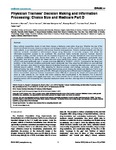Physician Trainees’ Decision Making and Information Processing: Choice Size and Medicare Part D
| dc.contributor.author | Barnes, AJ | |
| dc.contributor.author | Hanoch, Y | |
| dc.contributor.author | Martynenko, M | |
| dc.contributor.author | Wood, S | |
| dc.contributor.author | Rice, T | |
| dc.contributor.author | Federman, AD | |
| dc.date.accessioned | 2017-10-05T10:14:38Z | |
| dc.date.available | 2017-10-05T10:14:38Z | |
| dc.date.issued | 2013 | |
| dc.identifier.issn | 1932-6203 | |
| dc.identifier.issn | 1932-6203 | |
| dc.identifier.other | ARTN e77096 | |
| dc.identifier.uri | http://hdl.handle.net/10026.1/10009 | |
| dc.description.abstract |
Many patients expect their doctor to help them choose a Medicare prescription drug plan. Whether the size of the choice set affects clinicians' decision processes and strategy selection, and the quality of their choice, as it does their older patients, is an important question with serious financial consequences. Seventy medical students and internal medicine residents completed a within-subject design using Mouselab, a computer program that allows the information-acquisition process to be examined. We examined highly numerate physician trainees' decision processes, strategy, and their ability to pick the cheapest drug plan-as price was deemed the most important factor in Medicare beneficiaries' plan choice-from either 3 or 9 drug plans. Before adjustment, participants were significantly more likely to identify the lowest cost plan when facing three versus nine choices (67.3% vs. 32.8%, p<0.01) and paid significantly less in excess premiums ($60.00 vs. $128.51, p<0.01). Compared to the three-plan condition, in the nine-plan condition participants spent significantly less time acquiring information on each attribute (p<0.05) and were more likely to employ decision strategies focusing on comparing alternate plans across a single attribute (search pattern, p<0.05). After adjusting for decision process and strategy, numeracy, and amount of medical training, the odds were 10.75 times higher that trainees would choose the lowest cost Medicare Part D drug plan when facing 3 versus 9 drug plans (p<0.05). Although employing more efficient search strategies in the complex choice environment, physician trainees experienced similar difficulty in choosing the lowest cost prescription drug plans as older patients do. Our results add further evidence that simplifications to the Medicare Part D decision environment are needed and suggest physicians' role in their patients' Part D choices may be most productive when assisting seniors with forecasting their expected medication needs and then referring them to the Medicare website or helpline. | |
| dc.format.extent | e77096-e77096 | |
| dc.format.medium | Electronic-eCollection | |
| dc.language | en | |
| dc.language.iso | eng | |
| dc.publisher | Public Library of Science (PLoS) | |
| dc.subject | Adult | |
| dc.subject | Decision Making | |
| dc.subject | Electronic Data Processing | |
| dc.subject | Humans | |
| dc.subject | Medicare Part D | |
| dc.subject | Physicians | |
| dc.subject | Software | |
| dc.subject | United States | |
| dc.subject | Young Adult | |
| dc.title | Physician Trainees’ Decision Making and Information Processing: Choice Size and Medicare Part D | |
| dc.type | journal-article | |
| dc.type | Article | |
| plymouth.author-url | https://www.ncbi.nlm.nih.gov/pubmed/24116209 | |
| plymouth.issue | 10 | |
| plymouth.volume | 8 | |
| plymouth.publication-status | Published online | |
| plymouth.journal | PLoS ONE | |
| dc.identifier.doi | 10.1371/journal.pone.0077096 | |
| plymouth.organisational-group | /Plymouth | |
| plymouth.organisational-group | /Plymouth/REF 2021 Researchers by UoA | |
| plymouth.organisational-group | /Plymouth/REF 2021 Researchers by UoA/UoA04 Psychology, Psychiatry and Neuroscience | |
| plymouth.organisational-group | /Plymouth/Research Groups | |
| plymouth.organisational-group | /Plymouth/Research Groups/Centre for Brain, Cognition and Behaviour (CBCB) | |
| plymouth.organisational-group | /Plymouth/Research Groups/Centre for Brain, Cognition and Behaviour (CBCB)/Behaviour | |
| dc.publisher.place | United States | |
| dcterms.dateAccepted | 2013-08-30 | |
| dc.identifier.eissn | 1932-6203 | |
| dc.rights.embargoperiod | Not known | |
| rioxxterms.versionofrecord | 10.1371/journal.pone.0077096 | |
| rioxxterms.licenseref.uri | http://www.rioxx.net/licenses/all-rights-reserved | |
| rioxxterms.licenseref.startdate | 2013 | |
| rioxxterms.type | Journal Article/Review |


